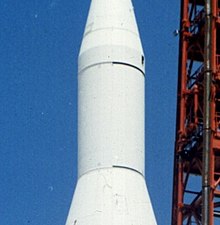S-V
 S-V stage on top of the S-IV | |
| Manufacturer | Convair |
|---|---|
| Country of origin | United States |
| Used on | Saturn I (stage 3) |
| General characteristics | |
| Height | 9.14 m (30.0 ft) |
| Diameter | 3.05 m (10.0 ft) |
| Gross mass | 15,600 kg (34,400 lb) |
| Propellant mass | 13,604 kg (30,000 lb) |
| Empty mass | 1,996 kg (4,400 lb) |
| Associated stages | |
| Family | Saturn |
| Derivatives | Centaur |
| Launch history | |
| Status | Retired |
| Total launches | 4 |
| Successes (stage only) | 4 |
| Failed | 0 |
| First flight | October 27, 1961 |
| Last flight | March 28, 1963 |
| S-V | |
| Powered by | 2 RL-10 engines |
| Maximum thrust | 133.45 kN (30,000 lbf) |
| Specific impulse | 425 s (4.17 km/s) |
| Burn time | 425 s |
| Propellant | LH2 / LOX |
The S-V (pronounced "S-five") was the third stage of the Saturn I rocket. It was built by Convair. It was designed to use two RL-10A-1 engines fueled by liquid hydrogen (LH2) and liquid oxygen (LOX) in tanks utilizing a common bulkhead to separate the propellants.
History[]
Convair Astronautics was awarded a contract to deliver the S-V stage for the Saturn I. The stage was intended to boost lift capacity for U.S. military launches in the 1960s. The S-V would ultimately fly as the third stage on early launches of the Saturn I. Convair delivered two S-V stages in February 1961[1] with one being flown on SA-1 attached to an also inert S-IV, the second was used for dynamic testing of the complete Saturn I before being later flown. In May 1961 NASA eliminated the requirement for all Saturn I launches to be flown with S-V's by flying in a two-stage only version. Despite this, the stage would fly four times in total.[2] With the introduction of the Saturn IB and the needs of the military fulfilled on other launches, all further launches would be on either the Saturn IB or Saturn V, each of which did not include the S-V. A version of this stage was also used on the Atlas-LV3C as the Centaur-C, modern derivatives of which are still flown today making it the only Saturn rocket stage still currently operating.
Flight history[]
Ultimately, the S-V would go on to fly four times between 1961 and 1964. Each of which were flown on suborbital test flights of the Saturn I. Because of the suborbital nature of these flights, each S-V was filled with water to act as ballast, making the stage inert. The water was released in space twice for Project Highwater. Modern derivatives of the stage are still in use today on the Atlas V and the planned Vulcan Centaur.
| Flight Number | Launch date
(UTC) |
Notes |
|---|---|---|
| SA-1 | October 27, 1961
15:06:04 |
First test suborbital flight. Apogee: 136.5 km. Inactive S-IV and S-V stages. |
| SA-2 | April 25, 1962
14:00:34 |
Second suborbital test flight. 86,000 kg water released at apogee of 145 km. Inactive S-IV and S-V stages. |
| SA-3 | November 16, 1962
17:45:02 |
Third suborbital test flight. 86,000 kg water released at apogee of 167 km. Inactive S-IV and S-V stages. |
| SA-4 | March 28, 1963
20:11:55 |
Fourth suborbital test flight. Apogee: 129 km. Inactive S-IV and S-V stages. |
References[]
- ^ "Saturn Illustrated Chronology - Part 2". history.nasa.gov. Retrieved 2020-09-16.
{{cite web}}: CS1 maint: url-status (link) - ^ "Saturn-1 (Block 1) (Saturn-I)". Gunter's Space Page. Retrieved 2020-09-16.
- Rocket stages
- NASA space launch vehicles